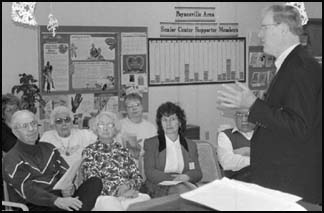 Congressman David Minge discussed Social Security reform with a group of citizens at the Paynesville Area Center on Monday. The DFL Representative is holding 27 town meetings throughout the Second Congressional District this month.
Congressman David Minge discussed Social Security reform with a group of citizens at the Paynesville Area Center on Monday. The DFL Representative is holding 27 town meetings throughout the Second Congressional District this month. Minge started by giving a brief history of the program, the current financial challenge, and options for reform. He took some questions before lunch, and continued the dialogue after that as well.
ďThe problem is manageable today,Ē said Minge, who pointed out that there was a $110 billion surplus in Social Security last year.
If current demographic trends continue, though, there will be a problem in the future. Lower birth rates, an aging population, and rising life expectancy rates combine to increase the number of recipients and decrease the number of tax-paying contributors. By 2020, the Baby Boom generation will be retiring and will be expecting to live longer and draw out more benefits. Meanwhile, there will be fewer workers.
ďThese demographic considerations have done more to drive the problem than anything else,Ē said Minge.
Around 2020, Social Securityís income will be surpassed by its payments. Then the trust fundís balance may evaporate quickly.
Minge also outlined several options for reform. One option is to increase the income into Social Security, either by raising taxes or by increasing the investment return on the Social Security trust fund. Currently, the money is invested in government bonds, which is very secure but yields low returns.
Another reform option is to decrease Social Security spending by either raising the retirement age, lowering the cost-of-living adjustment, or adjusting benefits according to wealth. All cause resentment, according to Minge. He said he had not met many people who wanted to wait longer for benefits or wanted to give theirs up.
Minge got two different perspectives from the audience, one saying that payroll taxes shouldnít be raised any more and the other feeling they should to insure benefits. ďItís a dilemma,Ē Minge concluded. ďWeíre not going to fix this without some belt tightening.Ē
A last option would be to transform the program either by privatization or by changing it to individual accounts.
Minge ended his presentation with five of his keys for reform.
First, reform should happen now. ďIf we wait, if we postpone,Öit becomes increasingly hard to actually carry out reform,Ē he said. The unpopular decisions reform will require causes politicians to hesitate. ďThis stuff is fraught with political peril,Ē conceded Minge.
Second, Minge said projections must be made using realistic numbers. Some have argued that there will be no Social Security crisis if the economy continues to grow at two percent a year. Minge said the problem is the economy has never grown by two percent a year for 25 straight years, so that wishful thinking is unrealistic.
Third, he said there should be generational fairness, and through neglect we shouldnít shift the heavy lifting to our children and grandchildren.
Fourth, he said the government should stop using the trust fund for other government expenditures. Currently, the government bonds are used for general spending, which gives a misleading deficit number. By counting the $110 billion surplus borrowed from Social Security, some claim the government ran in the black last year, but Minge said that without the surplus the deficit was $30 billion.
Fifth, some seniors depend heavily on Social Security for food, medication, and housing. Minge said the program needs to care for these vulnerable programs.